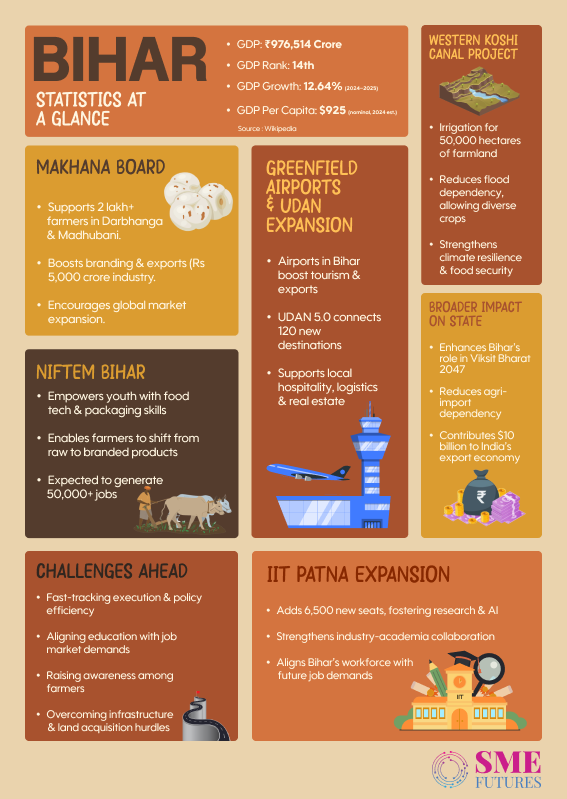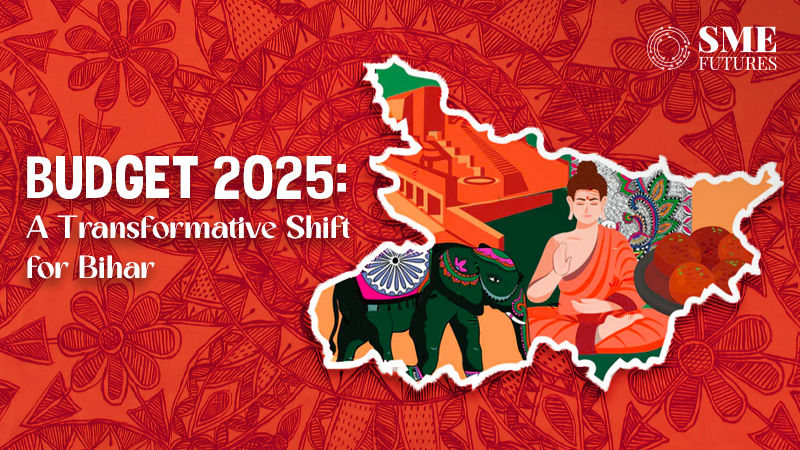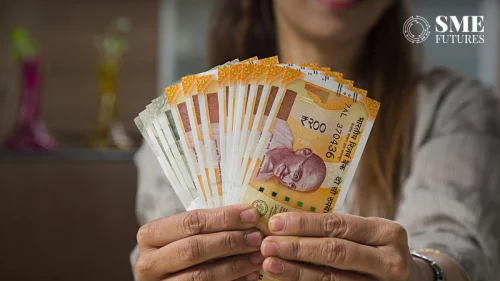The union budget for the year 25-26 tabled by Finance Minister Nirmala Sitharaman has been hailed for being progressive, forward-looking and inclusive for India’s vision of becoming a Viksit Bharat by 2047. While it outlines transformative moves and strategies across various sectors, one state has emerged as a clear winner: Bihar. From agriculture and food processing to aviation infrastructure, and education, Bihar has secured a slew of initiatives that promise to reshape its socio-economic landscape.
A budget for Bihar: Key announcements
Makhana Board: A Game-changer for Bihar’s farmers
One of the most significant announcements for Bihar is the establishment of the Makhana Board, aimed at boosting the production, processing, value addition, and marketing of makhana (fox nuts). Bihar, which accounts for over 80 per cent of India’s makhana production, has long struggled with fragmented supply chains and exploitation by middlemen.
Farmer empowerment: Over 2 lakh makhana farmers, primarily in the Darbhanga and Madhubani regions, will gain access to organised markets, fair prices, and training through Farmer Producer Organisations (FPOs).
Economic boost: Value addition—such as flavoured makhana snacks, protein powders, and ready-to-eat products—could create a Rs 5,000 crore industry, generating rural employment.
Global export potential: With rising global demand for healthy snacks, Bihar’s makhana could rival quinoa in international markets.
“The creation of the Bihar Makhana Board will help preserve and promote regional food heritage while strengthening rural economies. As consumers demand transparency and healthier choices, this budget sets the stage for a true farm-to-table revolution. The government’s commitment to self-sufficiency in pulses and investment in food technology and entrepreneurship will not only nourish our nation but also inspire the next generation to rediscover the grains and recipes of our ancestors,” said Teja Chekuri, founder of Full Stack Ventures.
“Bihar received special attention in the Budget, with the Centre aiding Makhana farmers by setting up Makhana Board to enhance production, processing, value addition, and marketing of Makhana. Food Processing Units shall also be set up in Bihar,” said Meghna Mishra, Senior Partner at Karanjawala and Co.
A local makhana farmer from Darbhanga shares his joy. “For years, we sold raw makhana at throwaway prices. Now, we can brand and market our products,” said Lallan Kumar Sahani, a Makhana dealer from Bihar.

National Institute of Food Technology, Entrepreneurship and Management (NIFTEM)
The budget proposes setting up a NIFTEM in Bihar to catalyse food processing in the eastern region. This aligns with Bihar’s potential as an agro-processing hub, given its surplus production of maize, litchi, and makhana.
This will create a huge impact in the state: from building the skills of the youth to bringing more value and employment in Bihar. With the help of these new institutes, the youth will be trained in food technology, packaging, and supply chain management, addressing the skill gap in Bihar’s agro-industry.
Another benefit would be value addition. Farmers can shift from selling raw produce to branded products (e.g., litchi juices, maize-based snacks), improving profitability.
Employment is another aspect that will be hugely appreciated by the youth of the state. Over 50,000 jobs could be created in processing units and allied sectors by 2030.
Biraja Rout, founder of Biggies Burger, also appreciates this initiative and hopes that it will bring more opportunities to the state and help it become a more integral part of the country’s economy.
“The National Institute of Food Technology in Bihar is a strategic development. By enhancing value addition for farmers and skilling youth, this initiative promises to strengthen supply chains and support the growth of the QSR industry in the region,” said Rout.
“The focus on capacity building for entrepreneurship, particularly through policy measures aimed at labour-intensive sectors, aligns seamlessly with the operational dynamics of the QSR industry. Such initiatives are expected to generate employment opportunities and stimulate economic activity within the sector,” pointed out Rout.
Greenfield Airports and UDAN expansion
The budget announces Greenfield Airports in Bihar alongside the expansion of Patna Airport. Additionally, the UDAN 5.0 scheme aims to connect 120 new destinations, including underserved regions in Bihar.
Greenfield Airports will boost tourism and exports of perishables like litchi and makhana.
Airports will also help in the development of the region they are developed around. Airports in cities like Darbhanga or Gaya could spur hospitality, logistics, and real estate growth.
The UDAN scheme, aimed at enhancing regional air connectivity and making air travel more affordable, has played a crucial role in integrating smaller cities into the national aviation network, further stimulating economic activity in Bihar.
“The Union Budget 2025-26 presents a transformative vision for India’s travel and tourism sector, reinforcing its role as a key driver of economic growth and employment. The expansion of the UDAN scheme will significantly enhance regional connectivity, making travel more accessible and affordable for millions. The facilitation of greenfield airports in Bihar further underscores the government’s commitment to strengthening aviation infrastructure across the country,” said Rikant Pittie, CEO, EaseMyTrip.
“Moreover, the proposed development of 50 top tourist destinations, coupled with performance-linked incentives for states, streamlined e-visa facilities, and visa-fee waivers, will position India as a more attractive global travel destination by easing out travel infrastructure,” pointed out Pittie.
Western Koshi Canal Project: Transforming Mithilanchal’s agriculture
The Union Budget 2025–26 has allocated substantial funds for the Western Koshi Canal Project in Bihar’s Mithilanchal region, a development poised to reshape the state’s agricultural sector. This initiative will bring irrigation to 50,000 hectares of farmland, providing crucial support to farmers in the flood-prone districts of Supaul and Saharsa. With consistent water supply, they will no longer be solely reliant on monsoon-dependent paddy cultivation and can instead diversify their crops to include maize, pulses, and other high-value produce, thereby increasing both yield and income.
In addition to enhancing agricultural productivity, the project plays a vital role in bolstering climate resilience in the region. Given the recurrent destruction caused by the Koshi River, the integration of flood management infrastructure aims to curb the impact of seasonal flooding. The project mitigates floods, protecting crops and livelihoods.
“The Centre’s focus on Aatmanirbhar agriculture, especially irrigation projects like the Western Koshi Canal, is a positive step towards achieving the vision of Viksit Bharat by 2047,” said Mishra.
IIT Patna expansion
The Union Budget 2025–26 has earmarked funds to expand hostel and infrastructure facilities at IIT Patna, enabling an additional 6,500 student enrolments. This expansion aims to bolster the institute’s contributions to research and innovation, particularly in artificial intelligence, sustainable energy, and agricultural technology.
Moreover, the initiative is expected to enhance collaboration between academia and industry, fostering partnerships in key sectors like food processing and renewable energy. By aligning academic research with industry demands, these collaborations will stimulate job creation, drive technological advancements, and contribute to the region’s economic development.
“The new policy announces the establishment of the Centre of Excellence for Artificial Intelligence in Education, with an allocation of Rs 500 crore, to make India lead the world in AI-enabled education and innovation,” said Dr. Silpi Sahoo, Chairperson of SAI International Education Group.
“The expansion of IIT Patna signals renewed efforts at innovation and research. Coupled with the Centre of Excellence for AI in Education, Bihar’s youth will lead India’s tech-driven future,” added Dr. Silpi Sahoo.
Broader implications for India
The recent budgetary gains for Bihar reflect broader national priorities that promise significant impacts beyond the state. Initiatives like the Makhana Board and pulses missions aim to boost domestic production, reducing India’s reliance on imports and enhancing food security. Additionally, the growth of Bihar’s processed food and textile industries is projected to significantly contribute to India’s export economy, potentially adding $10 billion by 2030. Investments in Bihar’s infrastructure not only support the state’s development but also promote balanced regional growth, aligning with India’s vision of equitable progress.
Challenges and the road ahead
While these initiatives are poised to transform Bihar, the state faces several critical challenges that must be addressed for sustained progress.
Implementation efficiency: Historically, schemes like the Bihar Industrial Investment Policy have struggled due to bureaucratic delays. To overcome this, a focus on time-bound execution is essential.
Skill development: For institutions like NIFTEM and IIT Patna to produce industry-ready graduates, curricula need alignment with current job market demands. Collaborating with corporates such as ITC and Patanjali can offer practical training opportunities, bridging the gap between academic knowledge and industry requirements.
Farmer awareness: While the establishment of a Makhana Board presents numerous benefits, many small-scale farmers remain unaware of its advantages. Grassroots awareness campaigns, facilitated by self-help groups and mobile applications in local languages, can play a vital role in educating farmers and maximising participation.
Infrastructure bottlenecks: The development of Greenfield Airports is often hampered by challenges in land acquisition and connecting infrastructure. Using PM Gati Shakti can resolve land acquisition issues.
By addressing these challenges, Bihar can fully harness the opportunities presented in the Union Budget, paving the way for sustainable development and contributing to India’s broader economic goals.
Budget 2025 marks a turning point for Bihar, transitioning it from a state grappling with migration and agrarian distress to a hub of innovation, connectivity, and sustainable agriculture. By addressing implementation challenges and fostering collaboration between farmers, industries, and institutions, Bihar can emerge as a model for equitable development. As Murty LVLN of Dvara KGFS aptly notes, “Bihar is an important geography for us, and these initiatives will bolster value-chain-based growth.” The nation’s eyes are now on Bihar – a state poised to script its own Viksit Bharat story.










